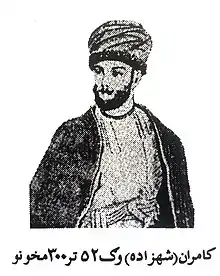Kamran Shah Durrani
Kamran Shah Durrani was born in the Sadozai dynasty. He was the son of Mahmud Shah Durrani, grandson of Timur Shah Durrani[2] and the great grandson of Ahmad Shah Durrani,[3] the founder of the Durrani Empire. He was deposed and killed in early 1842, by his vizier Yar Mohammad Khan Alakozai.[4]
| Shahzada Kamran Durrani | |
|---|---|
 | |
| Ruler of Herat | |
| Tenure | 1829–Early 1842 |
| Predecessor | Mahmud Shah Durrani |
| Successor | Yar Mohammad Khan Alakozai |
| Born | 1789 Herat, Durrani Empire |
| Died | Early 1842 |
| Issue | Nader Mirza[1] |
| House | Sadozai dynasty |
| Father | Mahmud Shah Durrani |
| Religion | Sunni Islam |
Reign
After Timur Shah's death in 1793, Afghanistan fell apart into multiple pieces. Eventually Mahmud Shah took the throne in 1809 and had as vazir Fateh Khan Barakzai. In April 1818, Fateh Khan conquered Herat for Mahmud but he got out of favour with him and thus Mahmud Shah and his son accompanied by allies repaid Fateh Khan's services by having him brutally assassinated in 1818. After the assassination of Fateh Khan Barakzai, the fall of the Durrani Empires had begun. Thus, after a bloody conflict, Mahmud Shah was deprived of all his possessions except Herat. The rest of his dominions were divided among Fateh Khan's brothers. King Mahmud Shah Durrani died in 1829. Herat was then after ruled by Kamran Shah. In Early 1842, he was deposed and killed in Kohsan on the orders of his Vazir Yar Mohammad Khan Alakozai. Most of his family migrated to Quetta in British India.[5]
See also
References
- Lee, Johnathan L. (1996). The "ancient Supremacy": Bukhara, Afghanistan, and the Battle for Balkh, 1731-1901. E.J. Brill. ISBN 9004103996.
- Timur Shah, ruler of Afghanistan
- "Archived copy". lcweb2.loc.gov. Archived from the original on 31 October 2004. Retrieved 13 January 2022.
{{cite web}}: CS1 maint: archived copy as title (link) - Noelle-Karimi, Christine (2014). The Pearl in Its Midst: Herat and the Mapping of Khurasan (15th-19th Centuries). Austrian Academy of Sciences Press. ISBN 978-3-7001-7202-4.
- "Shahzada Kamran Durrani". Mundigak. Retrieved 2022-11-02.